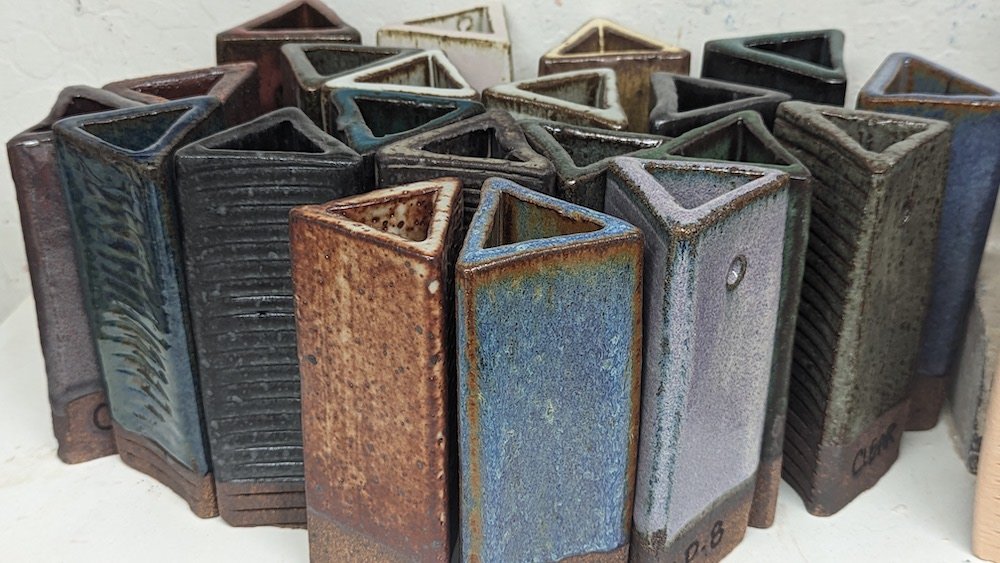WHAT THE FLUX!
GLAZING WITH CONE 10 REDUCTION GLAZES?
These application techniques can significantly impact your final result.
1. Dipping
Consistent Coverage: Dipping provides even coverage and is ideal for larger pieces. Make sure the glaze is well-mixed and at the right consistency. We test each batch for it’s Specific Gravity (ratio of solids content to water) for consistency.
Dip Time: Dip quickly to prevent the glaze from pooling at the bottom. A three to five-second dip is often sufficient, check the posted dipping guide for each glazes’ optimum dip time on each clay body. Due to different chemistries, dip times from glaze to glaze varies.
Viscosity: Some glazes at the correct specific gravity are thicker or thinner based on their chemical makeup. Don’t add water ever. Don’t dip longer because it seems thin. We check the every batch, so don’t worry.
Remove Excess: Allow the piece to drain and tap it lightly to remove any excess glaze. Sponge off any drips for even coating.
2. Brushing
Multiple Coats: Apply multiple thin coats (2-3) to build up color and depth. Allow each coat to dry before applying the next. Some of our glazes do well when brushed, most of our glazes do better when dipped or sprayed.
Brush Selection: Use brushes appropriate for the glaze's viscosity. A soft brush can help achieve smoother applications, while stiffer brushes may add texture.
Crosshatch Technique: Apply in different directions (horizontal and vertical) to avoid streaking.
3. Spraying
Fine Mist: Spraying allows for a fine, even coat, which is great for achieving smooth finishes. Adjust your spray gun for a fine mist.
Thin Layers: Apply several thin layers rather than one thick coat to avoid drips and runs. The final coating should be about 1.5 to 2.0 mm. (Slightly thicker than a dime.)
Distance Control: Maintain a consistent distance from the piece (usually around 6-12 inches) for even application.
4. Sponge Application
Textured Effects: Using a sponge can create interesting textures and patterns. This technique is excellent for decorative elements or to highlight specific areas.
Dabbing Technique: Lightly dab the sponge in the glaze and apply it to the surface, varying pressure for different effects.
5. Pouring
Controlled Application: Pouring is useful for achieving an even coat on the interior of functional ware like bowls or vases or for pieces larger than the glaze bucket.
Tilt and Rotate: Tilt the piece to allow the glaze to cover all surfaces, ensuring even distribution. Use one of our trays or metal bowls and a plastic pitcher to pour over your piece.
6. Layering Techniques
Glaze Combination: Layer different glazes for depth and complexity. Test combinations on sample tiles first and always use a cookie to protect the shelf. Pay attention to how the top layer may run over the bottom layer, so dip just the top half to start and see how much the top layer will run. ALWAYS use a cookie.
Resist Techniques: Use wax resist to create patterns, allowing for a two-tone effect where parts of the piece remain unglazed.
7. Stencils and Masking
Design Work: Use stencils or tape to create specific designs. This method can produce sharp lines and defined patterns.
Apply After Drying: Ensure the base glaze is completely dry before applying the masking or stencil for best results.
8. Control Glaze Thickness
Consistent Thickness: Aim for a consistent thickness (typically 1.5 to 2.0 mm). Use a gauge or ruler for accuracy if necessary. To get the feel for thickness, take a newly dipped test piece and scrape with a pin tool to see how thick the application is.
Test Pieces: Always do test pieces to determine the best thickness for achieving desired effects. All glazes will run if dipped for too long. Check the dipping guide for a start point. Adding a second layer can add to the running problem.
9. Mixing Glazes
Stirring: Glazes have a variety of raw materials suspended in water. Some of the materials can settle to the bottom so you will need to thoroughly mix with the wood paddles to make sure the glaze is completely mixed for repeatable application. Make sure you stir up again every 5 minutes because some glazes can quickly settle. Many poor outcomes are a result of not mixing enough. If a glaze is troublesome, please ask a staff member to power mix.
10. Waxing Bottoms
Wax: It is a best practice to keep the glaze about ¼” up from the bottom of your piece to avoid welding your piece to the kiln shelf. Waxing the bottom makes it easy to wipe of the glaze after dipping. When in doubt, always use a cookie. (We have to grind 10-15 kiln shelves each week when your piece runs due to over dipping, no cookie or not waxing the bottom ¼”.) if you drip wax on the side of a piece, either bisque fire again or incorporate into your design.
Best Practices for Repeatable Results
Test First: Always test application techniques and glaze combinations on small tiles or sample pieces.
Document Results: Keep a record of which techniques work best with specific glazes, clays and pieces for future reference. Your notes will help develop consistent results.
Experiment: Don’t hesitate to experiment with different techniques to discover unique effects that suit your style. We have many tools to spark ideas such as the glaze layering wall and layering book. Always experiment safely and sensibly.
Cleanup: Always leave an area cleaner than you found it.
The practice of Pottery has many parts. Many potters focus on the clay and its form. When it comes to glazing, some rush through because they aren’t familiar with the glaze techniques that finish their piece. By mastering these application techniques, you can enhance the beauty and complexity of your finished pieces and become a more well-rounded potter.

